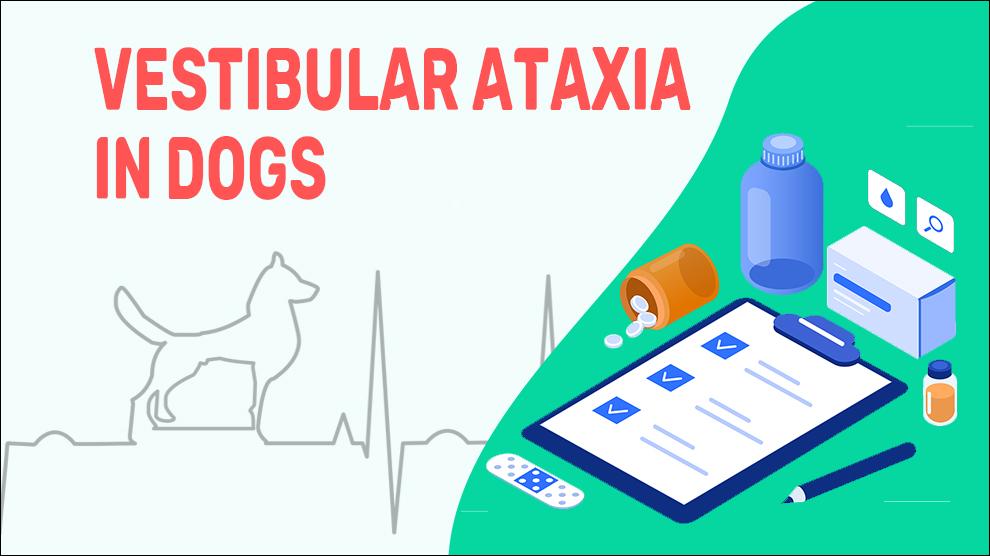What Is Vestibular Ataxia In Dogs?
Ataxia, defined as weakened synchronization of the movement of voluntary muscles, is a physical consequence, not a standalone disorder, and the original etiology needs to be diagnosed. The root word of "ataxia" is a Greek word ("a taxis") which means “in coordination or without order".
The ataxia that is easiest to recognize is Vestibular ataxia. This type of ataxia is characterized mainly by motion-dependent postural vertigo with shaky gait and stance, mostly on uneven ground and in darkness. With vestibular ataxia, it is also typical to see unusual eye movement, normally wandering from side to side. In an attempt to stay upright, dogs will often stand with their feet spaced out and they may usually tilt their head towards the side of the lesion in vestibular syndrome.
Sometimes with vestibular ataxia, the dog cannot stand and may roll on the side of the lesion or roll completely over. When the ataxia is caused by cerebellum dysfunction (lesion in the cerebellum), the dog will walk with an overreaching (overstepping) “goose-stepping” gait, called hypermetria.
Ataxia can have an insidious onset with an acute onset or also have a subacute onset (as in immunologic or infectious causes) or chronic and slowly progressive clinical course (genetic origin)
Symptoms Of Vestibular Ataxia In Dogs
- Dizzy spells caused by sudden head movements
- Blurred vision and other eye issues
- Broad stance
- Difficulty maintaining balance
- When making sudden turns, there will be a loss of balance
- Twitching of the eyes (Nystagmus) which is typically up and down, but can also be circular or sideways
- Tremors
- Stiffness of limbs
- The appearance of stroke or seizure
- Banging of the nose into food
- Nausea and vomiting
- Dilation of pupils
- Titubation (swaying or shaking of the trunk or head while sitting or standing)
Treatment Options For Vestibular Ataxia In Dogs
- Antihistamines - Chlorpheniramine, Cyproheptadine, Cetirizine, Clemastine, Trimeprazine, and Hydroxyzine
- NSAIDs
- Carprofen (Aventicarp,Carprieve, Canidryl, Rimadyl, Zinecarp, Carpox, Rimifin,Vetprofen)
- Firocoxib (Equioxx, Previcox)
- Meloxicam (Metacam, Muvera, Mobic)
- Etodolac (Lodine, EtoGesic)
- Deracoxib (Novartis, Deramaxx)
- Antibiotics such as chloramphenicol, gentamicin, amoxicillin, ciprofloxacin, tobramycin, oxytetracycline, etc
Home Remedies For Vestibular Ataxia In Dogs
- Help your dog have healthy ears with supplements
- Use a commercial ear cleansing agent (Eye Scrub) or physiological
- Cooled chamomile tea can be applied with a washcloth to clean the affected ears
- Use warm compresses for 10 to 20 minutes; apply them 2 to 3 times daily
How To Prevent Vestibular Ataxia In Dogs?
- The best way of ataxia prevention is to address the inflammation and itching at its initial stages.
- Discuss with your vet dermatologist for allergy shots.
- If your dog has a flea allergy, the best technique of control is avoidance.
- Using a medicinal Pre-Moistened wipe containing a skin disinfectant; clean the dogs regularly. Always dry the area completely after cleaning.
- The dog ears should be cleaned at least twice weekly with fresh paper napkins (or cotton washcloths), veterinary formula shampoo (e.g. vetMD medicated shampoo), spray, wipes, and skin cleanser.
Affected Dog Breeds Of Vestibular Ataxia
American Bulldog, Beagle, Bichon Frise, Doberman Pinscher, Boston Terrier, Shar Pei, Cavalier King Charles Spaniel, Chihuahua, English Springer Spaniel, German Shepherd, Golden Retriever, Jack Russell Terrier, Labrador Retriever, Lhasa Apso, Old EnglishSheep Dog, Scottish Terrier, Saint Bernard, Shih Tzu, Wirehaired Fox Terrier
Causes And Prognosis For Vestibular Ataxia In Dogs
1. Causes:
- Environmental factors (eg, pollens of trees, dust mites, molds and grasses, and weeds)
- Brain degeneration
- Certain medications
- Immunosuppression / autoimmune disorders
- Foreign objects inside the ear canal
- Cuts or abrasions
- Ectoparasites (flea allergies)
- Insect bites
2. Mortality:
There is no documented mortality due to this condition
3. Diagnosis:
- Complete blood count, chemistry panel
- Physical examination
- Otoscope
- Radiographs
4. Prognosis:
Prognosis depends on appropriate diagnosis and treatment for cases of Vestibular ataxia. Once the initial cause is appropriately addressed, the pet should completely recover within 2 weeks. Although, recurrence will be a problem following medical treatment in affected dogs. Untreated ataxia can lead to serious infection and agonizing issues.
When To See A Vet For Vestibular Ataxia In Dogs?
Contact your vet right away, if you notice any of the following:
- Dizzy spells caused by sudden head movements
- Blurred vision and other eye issues
- Broad stance
- Difficulty maintaining balance
Food Suggestions For Vestibular Ataxia In Dogs
- Consider a diet with Whole, organic foods and also provide sufficient antioxidants
- Lean meats: Lean beef (top loin, Tenderloin, ground round, and sirloin tip); 90% (or leaner) meat (beef, turkey, chicken)
- High protein, Low-fat foods - pork loin, turkey, fresh fish, salmon, canned tuna, shrimp, split Peas, Lentils, and Beans
- Omega-3 fatty acids- Salmon, tuna, Mackerel, sardines, Herring, chia seeds, flaxseed, etc
- Green Leafy vegetables: Beet greens, cabbage, Spinach, Broccoli, Green Beans, cauliflower, etc
Conclusion
The recovery time for Ataxia is different for every dog. Depending on the treatment plan or medication schedule prescribed by your vet, you’ll get a good idea of when to expect a complete recovery. Treatment may need to be evaluated often to stop recurrence. The prognosis is excellent when it is diagnosed early.

















